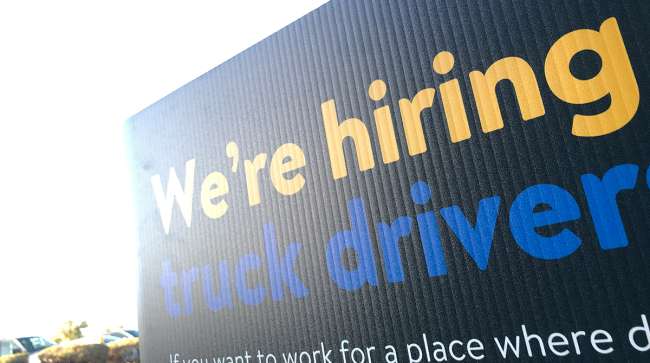Staff Reporter
Driver Shortage Defines Trucking for 2021

[Stay on top of transportation news: Get TTNews in your inbox.]
The shortage of professional drivers quickly became the defining issue for the industry during the past year with its far-reaching effects.
American Trucking Associations estimates that the industry needs 80,000 more drivers. That figure is expected to worsen in the years ahead with a lack of new drivers to offset retirements and growing demand.
“This year definitely feels different than driver shortages in the past,” Daniel Most, vice president of operations and safety at CPC Logistics, told Transport Topics. “It seems that no matter what you’re throwing at different markets, you’re just not getting responses.”
The shortage has existed for years, but it has been exacerbated by the coronavirus pandemic. ATA had estimated that prior to the pandemic the driver shortage was 61,500. Now the industry is competing over the same limited pool of drivers, which has resulted in turnover and numerous companies raising pay.

“I think that you can’t really talk about driver turnover looking at the last two years and not talk about COVID,” Scott Dismuke, director of operations at Professional Driver Agency, told TT. “I think what was interesting is kind of the shift from 2020 to 2021. I think in 2020, COVID actually kept drivers from jumping a whole lot. With the economy shutting down, everything froze.”
Dismuke added that the uncertainty kept workers in place for the first three months of the pandemic.
Turnover slowed to a crawl, and carriers weren’t looking for new drivers. But that eventually started changing as the industry was met with high freight demand.
“But once the economy really started opening back up at the end of 2020 and really through the first three quarters of this year, I think COVID had a different effect on turnover because you saw companies really raising pay, you saw a lot of active recruiting,” Dismuke said. “I think we saw the other side of the COVID effect with drivers starting to jump.”
Many carriers over the past year have announced pay raises and other incentives to help with recruitment and retention. Some even have raised pay multiple times. But in such a competitive labor market, that alone often has not been enough.
“Many carriers raised driver pay in 2021,” Priscilla Peters, vice president of marketing and training at Conversion Interactive Agency, told TT. “However, in most cases, that didn’t move the needle as expected for driver recruiting. Quality of life for the driver and home time have become the pieces of the driver recruiting puzzle where carriers are making adjustments that have impact.”

Dismuke
On Dec. 1, Professional Driver Agency and Conversion Interactive Agency released a survey on recruitment and retention. It found that 81.1% of drivers prefer a guaranteed pay model, 25.4% prefer a pay-per-mile model and only 13.4% prefer incentive-based pay. The 1,197 respondents were allowed to choose more than one preference.
“It’s not necessarily just the pay rate,” Dismuke said. “I think it’s also companies finding different and unique ways to pay. I think you’re starting to hear a lot about guaranteed pay, and you’re starting to hear a lot about incentive-based pay. A lot of companies are looking at that because at the end of the day, really, drivers look for predictable pay and they look for predictable home time.”
Dismuke added companies have to be careful when they talk about guaranteed pay because drivers still have to qualify. But from a marketing standpoint, he noted, it is useful for carriers to promise pay-per-mile increases and guaranteed pay models. But if the promises don’t hold up to expectations, it could impact retention.

Peters
“I think that has contributed to a lot of the driver churn,” Dismuke said. “What we’ve seen from our data consistently for three years now, is that when drivers are complaining about compensation, they’re complaining more about miles than they are about pay rate. It’s inconsistent miles, it’s poor scheduling and planning of loads, it’s load and unload delays, it’s loads that aren’t available.”
The survey also found that when drivers decide to leave a carrier the top issues are compensation (33.9%), home time consistency (21.6%), frustration (11%), communication (8.7%), relationship with driver manager (7.5%) and equipment quality (6.4%).
“Equipment shows up as a top issue for drivers, and equipment concerns are top of mind for driver recruiting leaders in the industry,” Peters said. “With a strong freight market, fleets want to grow, but motor carriers are facing equipment and parts shortages that are creating challenges.”
The survey also found that the majority of drivers (65%) are not looking for different driving jobs despite high turnover. This suggests that recruitment efforts by other carriers are a major reason drivers go to work for someone else.

Most
“Everything that you see is talking about what drivers are looking for,” Most said. “It’s the home time built in with good pay, built in with the schedules that they’re looking for. A lot of the jobs that we hire for require unloading freight. That makes it even more challenging, and so it just seems like you have to really adjust the type of work that you’re hiring for in order to get the candidates to start to pile in.”
The DRIVE-Safe Act is a potential solution to start growing the workforce again. The bipartisan bill would set up an apprenticeship process and promote opportunity for younger drivers. Currently, professional drivers younger than 21 cannot drive interstate. The law would help work around those restrictions while including safety training.
“I think the two options are creating a program where individuals can move into this field at a younger age where we’re not forced to try and peel them away as a second career option after they’ve already been doing something or target more of those other similar-type positions,” Most said.
He pointed to progress made in recruiting military drivers into the industry after their service and also suggested there could be more focus on recruiting female and minority drivers.
Want more news? Listen to today's daily briefing below or go here for more info:


